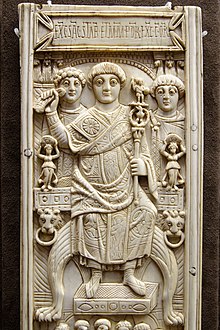Areobindus Dagalaifus Areobindus

Flavius Areobindus Dagalaifus Areobindus[1][2][3] (Greek: Ἀρεόβινδος; fl. 479–512) was an Eastern Roman general and politician. The scion of a distinguished line, he led troops in the Anastasian War, and served as consul in 506. During an urban riot in 512, Areobindus evaded a mob which wanted to force a change of government by proclaiming him emperor. He died soon after.[4]
Origins and family
Areobindus was born into an extremely distinguished family, which combined Roman and barbarian heritage:[4] his father was Dagalaifus (c. 430 – after 461), consul in 461, who in turn was the son of Areobindus, consul in 434, both of Gothic origin. His mother was Godisthea (born c. 445), daughter of Ardabur, general and consul in 447, and granddaughter of Aspar, the powerful Alan general and consul in 434.[5]
Shortly after 478, Areobindus married Anicia Juliana (after 461 – 527/528), daughter of the Western Roman emperor Olybrius and his wife Placidia. Together they had a son, Olybrius (c. 480 – after 524/527), consul in 491. Another possible descendant is Dagalaiphus (perhaps by an earlier wife).[6]
Career
In his consular diptychs, Areobindus is listed as having occupied the post of
He was living in retirement at Constantinople in 512, at a time when the open advocation of
Diptychs
Five examples of his consular diptychs have survived:[4] two complete and three half ones. The two complete ones are located in Lucca (CIL XI, 8137) and Zürich (CIL XIII, 5245); two halves with the name only are located at Paris and Besançon, and a further half with his titles is preserved at Dijon (CIL XIII, 10032, examples .3b, .3d and .3c respectively).[5]
References
- ^ Bagnall et al., p. 547.
- Brill's New Pauly, Areobindus
- ^ RE Dagalaifus 3
- ^ a b c Kazhdan (1991), p. 162
- ^ a b c d Martindale (1980), p. 143
- ^ Martindale (1980), pp. 143, 635–636, 795
- ^ a b c d e f Martindale (1980), p. 144
- ^ Greatrex & Lieu (2002), p. 68
- ^ Greatrex & Lieu (2002), p. 69
- ^ Greatrex & Lieu (2002), p. 72
Sources
- ISBN 1-55540-099-X.
- ISBN 978-0-486-20398-0
- Greatrex, Geoffrey; Lieu, Samuel N. C. (2002), The Roman Eastern Frontier and the Persian Wars (Part II, 363–630 AD), Routledge, ISBN 0-415-14687-9
- ISBN 0-19-504652-8.
- ISBN 0-521-20159-4.
